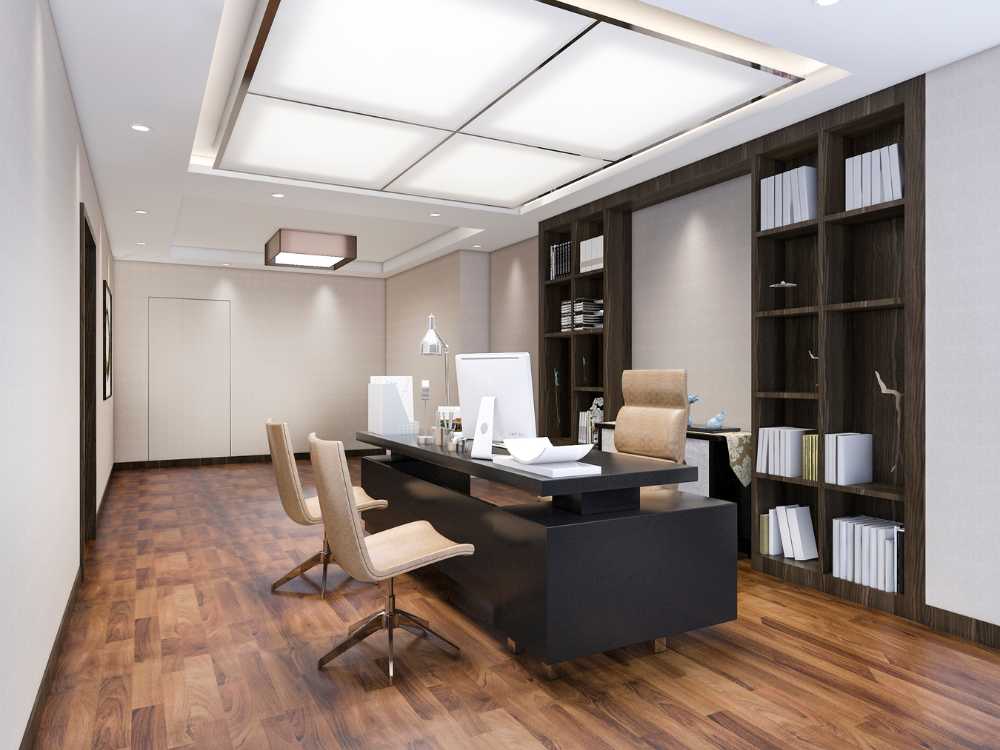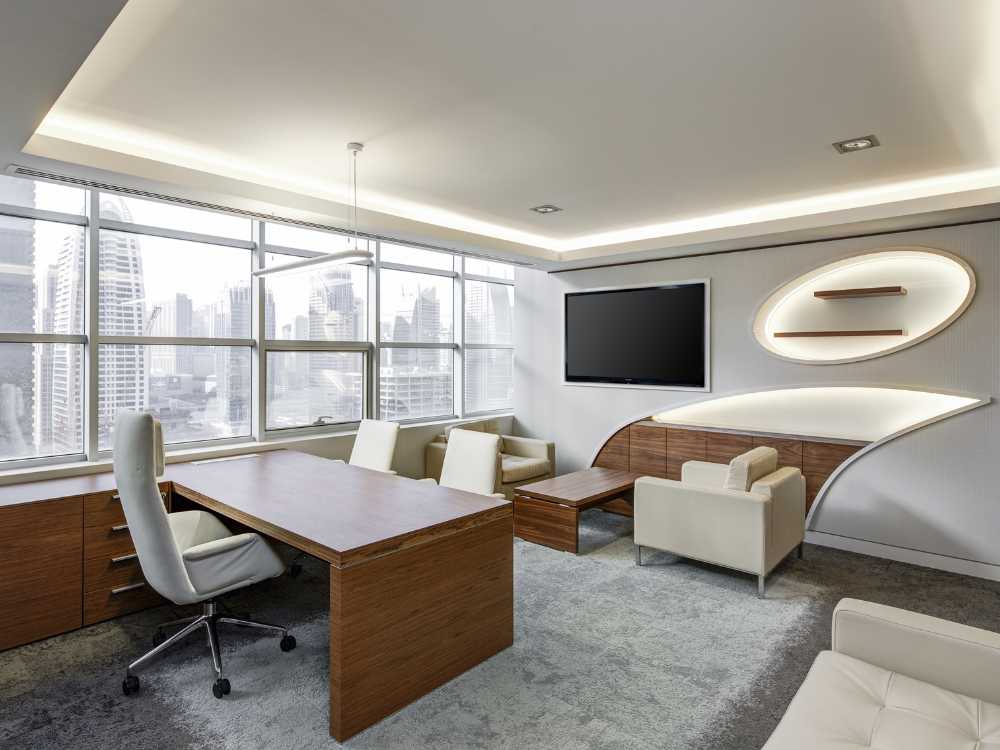Executive office furniture does more than fill a room—it sets the tone for how a business presents itself to clients, partners, and employees. In Stamford, Connecticut, where corporate growth continues to shape the skyline, selecting the right furnishings is both a design decision and a strategic investment. Whether launching a new workspace or refreshing an established one, understanding how to navigate the process—from sourcing to installation—can make or break timelines and budgets.
Here are five essential areas to focus on when sourcing executive office furniture in Stamford.
Key Takeaways |
✔ Stamford’s growing business scene demands executive furniture that reflects professionalism, functionality, and brand identity.
✔ Executive office furniture should balance comfort, quality materials, and design to support leadership and workflow.
✔ Combining local vendors with importing furniture from manufacturers offers flexibility, style variety, and cost control.
✔ A well-managed furniture supply chain ensures timely delivery, fewer disruptions, and long-term value.
✔ Partnering with full-service vendors streamlines furniture sourcing, custom furniture sourcing, and installation.
✔ Budgeting smartly means factoring in customization, logistics, and future growth to avoid overspending.
✔ Preparing the office with accurate measurements, site access, and support for on-site furniture assembly services avoids delays and damage.

Stamford is more than just a city—it’s a growing business hub with a mix of finance, healthcare, tech, and creative industries. Executive offices here range from high-rise corporate suites to boutique firm spaces, each with specific furnishing needs. Understanding the local business environment helps companies align their furniture sourcing decisions with space, brand, and function.
Executive office furniture goes far beyond a simple desk and chair—it reflects leadership, professionalism, and long-term functionality. In Stamford, where high-end offices often serve as client-facing spaces, furniture choices must balance aesthetics, comfort, and purpose. Clear definitions and goals prevent costly missteps during furniture sourcing and custom furniture sourcing efforts.
Stamford businesses have a unique advantage—they can tap into a local network of showrooms and suppliers while also importing furniture from manufacturers abroad. Each sourcing route comes with benefits and trade-offs, and smart decision-making depends on budget, timeline, and office design goals. A hybrid model often works best, especially when combined with reliable end-to-end furniture logistics.
Getting executive furniture into an office isn’t as simple as a curbside drop-off. Stamford’s mix of modern skyscrapers and older buildings often requires detailed planning, permits, and coordination. Working with professionals who manage end-to-end furniture logistics ensures that pieces arrive on time, undamaged, and installation-ready.
Finding the right office furniture goes beyond selecting pieces—it’s about working with partners who manage every stage, from design advice to on-site furniture assembly services. Stamford businesses that prioritize vendor quality avoid delays, miscommunication, and added costs. A vendor’s capabilities often determine how smooth the entire furniture sourcing process will be.

Planning an executive office upgrade means balancing premium style with practical costs. In Stamford, where office spaces range from boutique firms to enterprise headquarters, a solid budget ensures smart furniture sourcing without sacrificing quality or function. The key is understanding where to invest, where to negotiate, and how to make every dollar count across the furniture supply chain.
Instead of buying everything at once, businesses should focus first on high-impact pieces like executive desks, ergonomic chairs, and boardroom tables. These staples define workspace function and professional image, making them ideal targets for premium investment. This phased furniture sourcing approach prevents overspending while keeping quality where it matters most.
Many Stamford offices benefit from custom furniture sourcing, especially for uniquely shaped rooms or branded interiors. Setting aside a dedicated portion of the budget for custom pieces ensures flexibility without affecting core spending. This also allows teams to personalize executive spaces while staying in control of costs.
Overlooking transportation is one of the most common budgeting mistakes. Whether working with local vendors or importing furniture from manufacturers, businesses must account for freight, handling fees, and end-to-end furniture logistics. Including these early prevents surprises that could delay installations or blow past financial limits.
It’s smarter to buy fewer, higher-quality pieces than to fill a space with lower-tier furniture that needs frequent replacement. Durable materials and solid construction reduce long-term costs and stress on the furniture supply chain. Many Stamford firms take this approach when outfitting executive suites and meeting spaces.
Price comparisons should factor in more than just item cost. Some vendors include on-site furniture assembly services, white-glove delivery, or maintenance plans as part of their pricing. Weighing these extras against competitors gives a clearer picture of overall value during the furniture sourcing process.
A good office furniture budget considers future changes—such as expansion or executive transitions. Modular options and scalable designs help avoid full replacements, especially when importing furniture from manufacturers could mean long lead times. Building flexibility into the budget supports long-term success and eases pressure on the furniture supply chain.
Office furniture isn’t just functional—it reflects how a company sees itself and how it wants to be perceived. In a place like Stamford, where industries range from corporate finance to creative startups, aligning furniture style with company culture makes a lasting impression. Smart furniture sourcing choices ensure executive spaces feel intentional, not generic, while supporting workflow and identity.
Executive offices with bold, clean lines and solid wood pieces often suit companies with traditional leadership and a formal business tone. In contrast, open layouts with lighter finishes and soft textures signal collaboration and accessibility. Custom furniture sourcing allows Stamford businesses to match executive style with management philosophy in a thoughtful way.
A law firm may lean toward rich mahogany desks and leather seating, while a tech startup might choose brushed steel frames and minimalist modular units. Choosing the right materials not only boosts durability but also helps meet industry-specific expectations. This makes furniture sourcing more than a logistics task—it becomes a branding opportunity.
Furniture colors and fabric finishes can reinforce brand personality—whether that’s calm and understated or bold and modern. Accent walls, upholstery, and even desk trim can all mirror brand palettes. Working with vendors experienced in custom furniture sourcing helps ensure color consistency, especially when importing furniture from manufacturers with specific design requirements.
A culture that values privacy might need enclosed desks and dedicated meeting zones, while an agile team might prefer flexible, collaborative setups. These layout choices influence furniture supply chain decisions and impact how long it takes to get specialized pieces in place. Stamford offices benefit from clear planning to align spatial design with company values.
Executive furniture should feel elevated, but not so exclusive that it disconnects from the broader team environment. Consistent design themes across offices, common spaces, and meeting areas help maintain unity, especially as modular workstations continue to prove functional and durable—adapting to shifting workplace needs and innovations from 2018 to 2033. Full-service vendors who manage end-to-end furniture logistics and on-site furniture assembly services can coordinate these transitions smoothly.
Furniture choices should support company evolution—style shouldn’t feel outdated after one year. Selecting pieces that can be reconfigured, expanded, or paired with future elements keeps the brand fresh while minimizing changes to the furniture supply chain. Whether through local showrooms or importing furniture from manufacturers, Stamford firms can build style with staying power.
Even the most carefully selected furniture can create headaches if the office isn’t ready when it arrives. In Stamford’s fast-paced business environment, where time and space are premium, preparing the site properly ensures smooth setup and protects investments. From freight coordination to on-site furniture assembly services, every detail matters when working with a tight schedule and high expectations.
Blocked hallways and crowded rooms slow down deliveries and increase the risk of damage. Clearing the space before the scheduled delivery date allows vendors to bring in pieces efficiently and start on-site furniture assembly services without delays. In Stamford’s multi-tenant buildings, this step is often required by property management.
Many commercial buildings in Stamford have specific rules for elevator use, dock scheduling, and after-hours access. Teams should secure approvals and reserve loading zones at least a week in advance. Smooth end-to-end furniture logistics depend on aligning vendor schedules with building policies.
Installing executive furniture often involves heavy lifting and movement through tight areas. Protective floor runners, wall guards, and corner bumpers reduce damage to finishes during transport and assembly. Vendors experienced in furniture sourcing usually bring these items, but it’s smart to confirm in advance.
A common mistake is assuming furniture will fit just because the room is large enough. Detailed measurements—accounting for doors, ceiling heights, and wall outlets—help prevent issues with custom furniture sourcing and complex layouts. This is especially important when importing furniture from manufacturers, where return options may be limited.
Executive desks, conference tables, and workstations often require nearby outlets or network ports for seamless operation. Ensuring power sources are in place before assembly avoids costly rework or downtime. Stamford businesses working with full-service vendors should communicate these needs as part of end-to-end furniture logistics.
Even premium pieces can arrive with complex instructions or missing parts if vendors aren’t properly coordinated. Having trained technicians ready for on-site furniture assembly services ensures fast, accurate installation. Reputable suppliers streamline this process through consistent tracking across the furniture supply chain.
Late winter through early spring is often ideal for furniture sourcing, especially in Stamford where office renovations and relocations ramp up before summer. This timing allows for smoother coordination with vendors and building access before peak moving seasons. It also helps businesses avoid delays in the furniture supply chain due to holiday slowdowns or year-end backlogs. Starting early gives companies more flexibility for custom furniture sourcing or importing furniture from manufacturers if needed.
Yes, leasing is an option for companies that want flexibility or need to stage temporary executive spaces. While it may cost more long-term, leasing reduces upfront costs and simplifies end-to-end furniture logistics since many providers handle transport and removal. Some Stamford vendors offer leasing programs with premium selections and optional on-site furniture assembly services. However, leasing limits customization options compared to direct furniture sourcing or custom furniture sourcing.
Green certifications like GREENGUARD or FSC indicate the furniture meets environmental and health standards, which is important for sustainability-minded companies. In Stamford, more businesses are requesting certified products during furniture sourcing to align with ESG goals or LEED-certified buildings. Choosing eco-certified items may slightly impact cost or furniture supply chain availability but can strengthen a brand’s environmental profile. When importing furniture from manufacturers, be sure to verify documentation meets U.S. standards.
Absolutely—modular furniture, mobile workstations, and collapsible conference tables work well for hybrid work environments. These options support reconfiguration and save space, which is crucial in Stamford’s modern offices with shifting work habits. Through custom furniture sourcing, companies can tailor layouts to balance in-office presence and remote flexibility. It’s also important to plan end-to-end furniture logistics for future changes or expansions.
If damage occurs, the vendor’s warranty and shipping insurance typically determine how it’s handled. That’s why it’s important to work with a supplier that offers full end-to-end furniture logistics and clear support policies. Stamford companies should request proof of insurance and understand who manages claims when importing furniture from manufacturers. Reliable partners in the furniture supply chain will often provide replacements or fast repairs with minimal disruption.
Stamford Office Furniture brings professional design, seamless furniture sourcing, and reliable on-site furniture assembly services to businesses in White Plains, NY. From executive suites to collaborative spaces, our team delivers high-quality solutions backed by decades of experience and a smooth end-to-end furniture logistics process. Whether it’s importing furniture from manufacturers or crafting a personalized layout through custom furniture sourcing, we make every project efficient and tailored.
For White Plains offices ready to elevate their environment, Stamford Office Furniture is the trusted partner to get it done right.